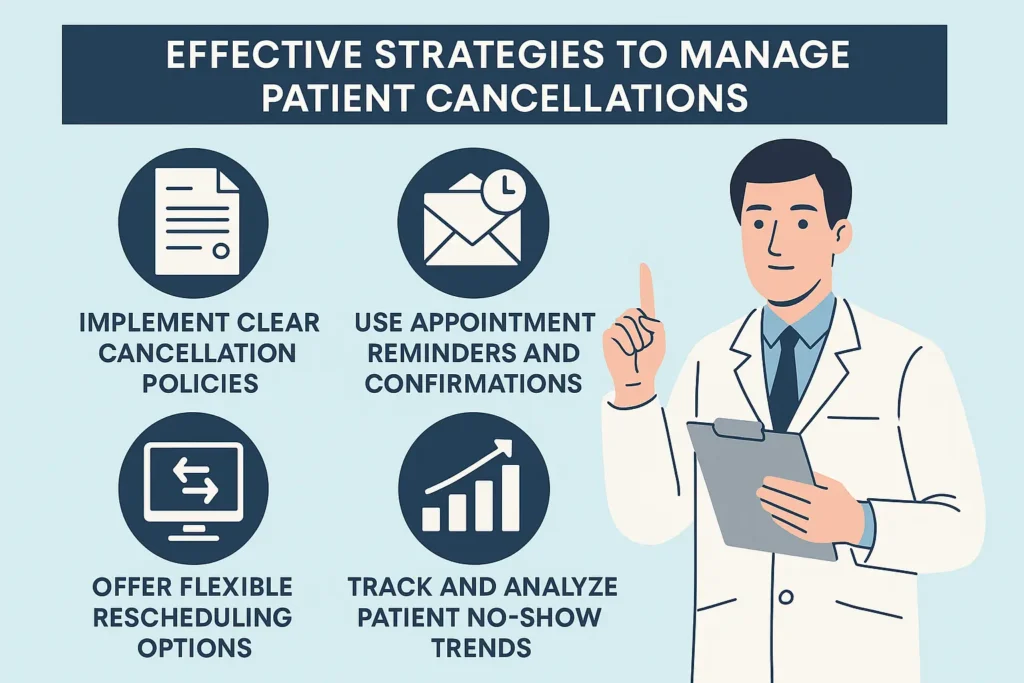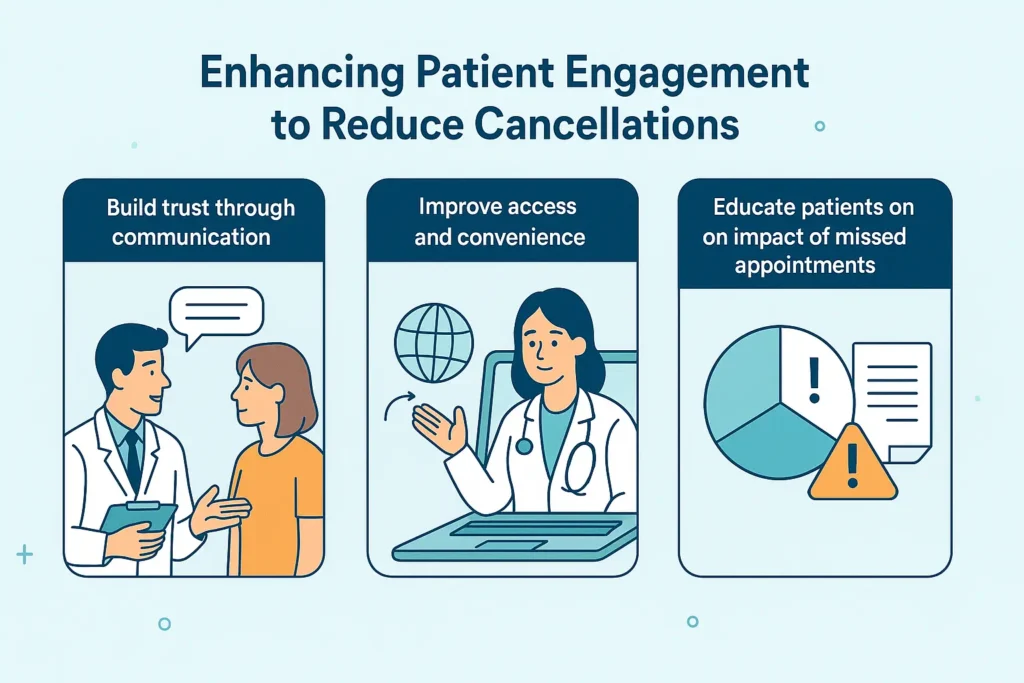Every healthcare provider faces it: a patient cancels their appointment at the last minute, or doesn’t show up at all. While cancellations may seem like an inevitable part of medical practice, their financial and operational impact is substantial.
Industry reports estimate that missed appointments cost the U.S. healthcare system around $150 billion annually, with physicians losing approximately $200 for each unused time slot. Beyond lost revenue, no-shows disrupt scheduling, waste staff time, and diminish continuity of care.
For hospitals, specialty clinics, and physician groups, these gaps create what revenue cycle experts call avoidable revenue leakage. When multiplied across dozens or hundreds of encounters each month, cancellations can undermine financial stability, frustrate staff, and reduce access for other patients.
So, what is the best approach to handling patient cancellations? The answer lies in structured policies, patient-centered communication, and data-driven revenue cycle management (RCM).
What Is the Best Approach to Handling Patient Cancellations?
The best approach combines consistency, compassion, and compliance.
Why cancellations matter for revenue cycle management
Each missed appointment represents unrealized revenue. Consider this: if a practice averages $150 per visit and loses 20 appointments monthly, that equals $36,000 annually in direct losses. Studies by the Medical Group Management Association (MGMA) suggest that these numbers are conservative; in high-volume practices, the impact can climb into the hundreds of thousands annually.
Beyond revenue, cancellations disrupt the revenue cycle itself—delaying coding and billing, lowering claim submission volume, and increasing administrative costs per encounter. Practices that partner with Cadence Collaborative’s revenue cycle management experts can better quantify and reduce these financial impacts.
Balancing patient care and business efficiency
Healthcare leaders also recognize that appointments are not simply transactions. Cancellations must be managed in ways that safeguard continuity of care while also protecting financial performance. The optimal strategy blends accountability with empathy: patients are reminded of their responsibility while still feeling supported when life circumstances require flexibility.
Common Reasons for Patient Cancellations
Understanding why patients cancel is essential to designing effective interventions.
Personal and health-related reasons
Many cancellations occur for unavoidable reasons: illness, family emergencies, transportation issues, or childcare conflicts. According to the CDC’s Social Determinants of Health framework, lack of reliable transportation is one of the leading non-clinical reasons patients miss care. Providers who recognize these barriers are better positioned to adapt scheduling practices and offer alternatives like telehealth.
System and practice-related factors
Cancellations are not always patient-driven. Inefficient scheduling systems, long wait times, or unclear communication from staff can frustrate patients and drive cancellations. A fragmented reminder process, or worse, no reminder at all, often contributes directly to higher no-show rates. Modernizing these workflows with healthcare consulting services helps practices close these operational gaps.
Patterns and recurring no-shows
Some patients develop a pattern of repeated cancellations or chronic no-shows. Research shows that patients who miss one appointment are 70% more likely not to return within 18 months. These patients often require targeted interventions, such as extra reminders, direct outreach, or modified scheduling policies.
Effective Strategies to Manage Patient Cancellations

Implement clear cancellation policies
The foundation of cancellation management is clarity. Patients should know:
- How far in advance they must cancel.
- Whether late cancellations incur fees.
- How repeat cancellations affect scheduling privileges.
Importantly, policies must comply with payer contracts and state-specific regulations. Cadence Collaborative helps organizations implement policy frameworks that are compliant and patient-friendly, ensuring accountability without compromising trust.
Use appointment reminders and confirmations
Multiple studies confirm that reminders reduce no-shows. Best practices include:
- Sending reminders one week before and again 24–48 hours prior.
- Using SMS, email, and automated calls.
- Offering easy “confirm” or “reschedule” options in each reminder.
- Providing reminders in multiple languages for diverse patient populations.
MGMA has identified reminder systems as one of the most effective, low-cost tools for reducing missed appointments.
Offer flexible rescheduling options
Today’s patients value convenience. Online portals, mobile scheduling apps, and telehealth visits make it easier to reschedule rather than cancel outright. Practices that offer same-week reslots or virtual visits often see measurable decreases in cancellations.
Track and analyze patient no-show trends
Analytics can identify high-risk time slots, patient demographics, or specific providers with elevated cancellation rates. Outpatient no-show rates range widely, from 5% to 30% depending on specialty, and in some extreme cases up to 50%.
By tracking patterns, practices can proactively adjust schedules, offer double-booking in high-risk slots, or apply targeted reminders for frequent no-shows.
Leverage staff training and scripting
Front-office staff often set the tone. Well-trained staff with clear scripts can handle cancellations professionally, ensuring patients feel supported while keeping the schedule intact. For example:
“Thank you for letting us know. Let’s reschedule now so you can stay on track with your care.”
This type of scripting preserves relationships while minimizing lost revenue.
Financial and RCM Considerations
Calculating the cost of patient cancellations
Lost revenue per cancellation is only the tip of the iceberg. Practices also lose staff productivity, pay overhead for unused slots, and miss opportunities for downstream care. For multi-specialty groups or hospitals, the aggregate impact can easily climb into millions of dollars annually.
Charge fees vs. waivers
Some providers implement cancellation fees to discourage no-shows. While effective in some cases, fee-based models must be applied with care to avoid alienating patients or violating payer rules. Waivers for emergencies can maintain goodwill, while consistent enforcement of policies supports fairness.
Protecting provider revenue through proactive strategies
Proactive RCM strategies are more sustainable than punitive measures. Predictive scheduling models, automated workflows, and no-show risk scoring allow providers to anticipate cancellations and mitigate financial loss. At Cadence Collaborative, we work with practices to integrate these approaches into the revenue cycle, minimizing leakage while maintaining patient trust.
Enhancing Patient Engagement to Reduce Cancellations

Build trust through communication
Patients who feel heard and respected are more likely to keep appointments. Transparent communication about why visits matter, for their health and for access to care overall, strengthens accountability.
Improve access and convenience
Telehealth reduces cancellations by offering alternatives when patients face transportation or scheduling challenges. For rural and underserved communities, virtual care can transform access and continuity (HHS Telehealth Hub).
Educate patients on the impact of missed appointments
Education is key. Patients often don’t realize that missed visits delay their care, reduce provider availability for others, and raise costs across the system. Clear explanations, delivered via portals, reminders, or in-office materials, help patients understand their role in maintaining efficient care delivery.
Conclusion
So, what is the best approach to handling patient cancellations? The answer is strategic balance:
- Clear, compliant policies.
- Automated reminders and flexible scheduling.
- Data-driven tracking of no-show trends.
- RCM strategies that protect revenue.
- Patient engagement initiatives that build trust.
While cancellations are inevitable, their impact doesn’t have to be. With the right systems, providers can reduce no-shows, strengthen revenue cycle performance, and improve patient satisfaction.
At Cadence Collaborative, we partner with healthcare organizations to address these challenges. Our expertise in revenue cycle management, medical billing, and patient engagement strategies helps providers minimize cancellations while building stronger, more resilient operations.
Ready to reduce cancellations and protect your revenue cycle? Partner with Cadence Collaborative today to implement proven strategies that optimize workflows and improve both financial and clinical outcomes.






